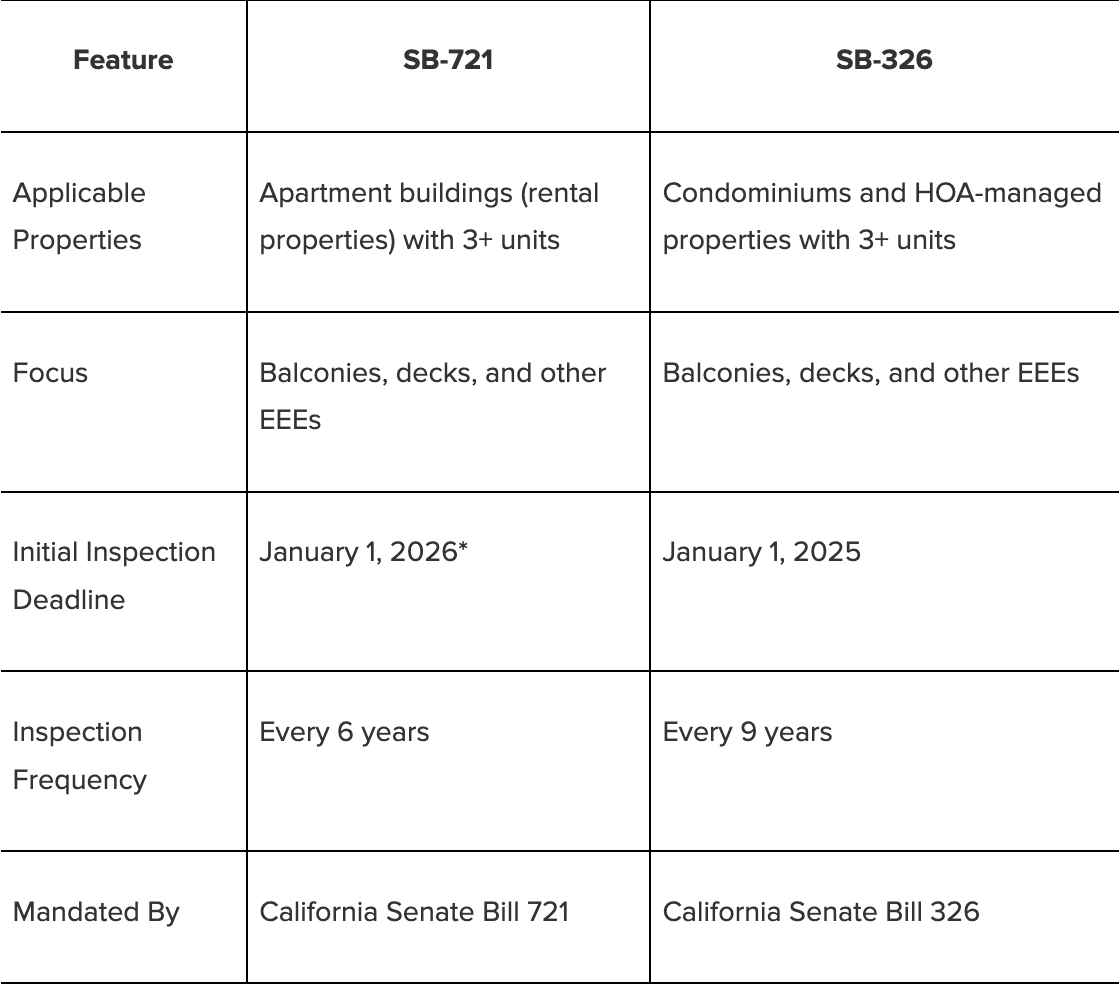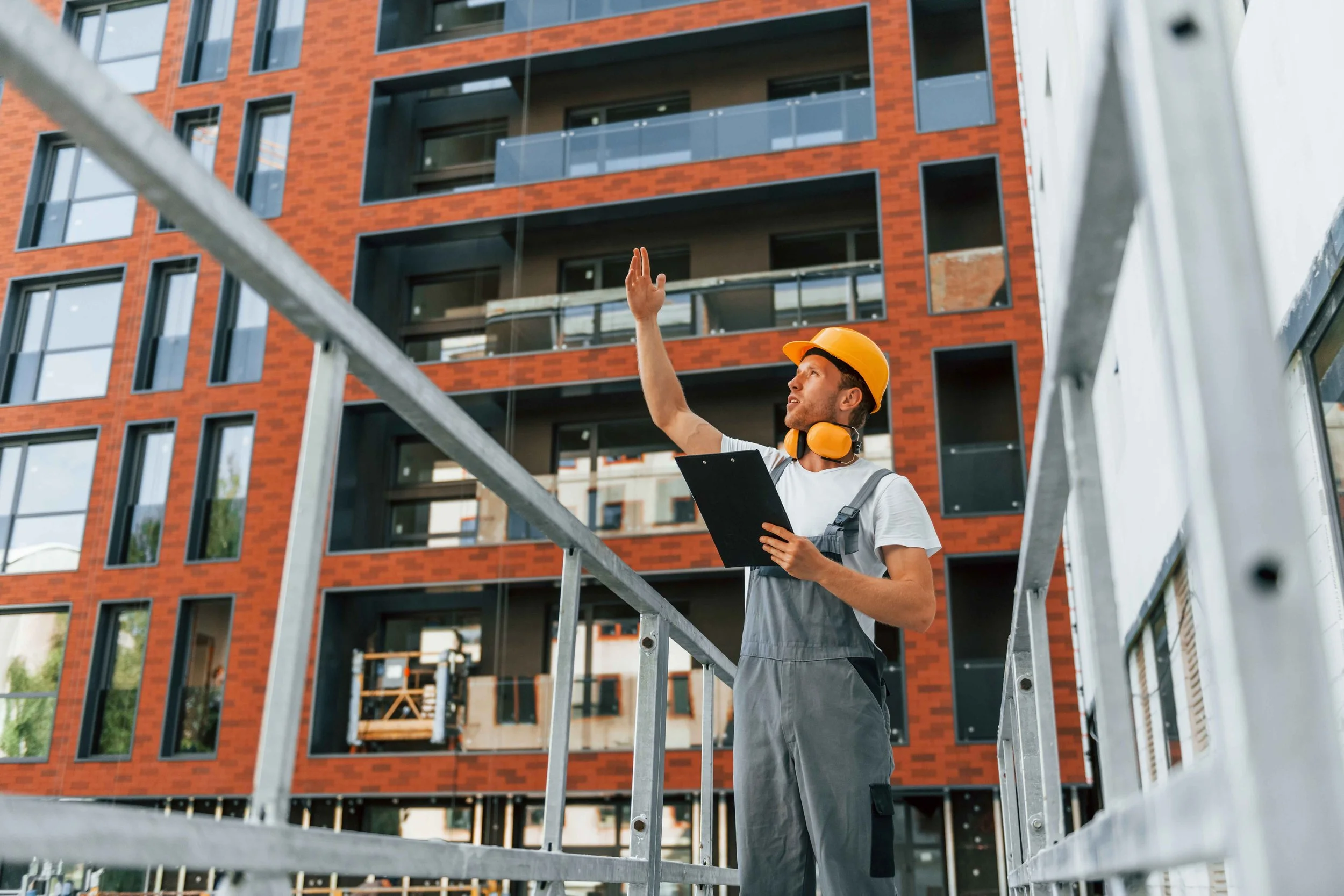Balcony Inspection Checklist: Warning Signs Every Property Manager Must Know
A well-defined balcony inspection checklist is essential for property managers overseeing aging structures—especially with over 40 million decks in the U.S. now surpassing 20 years of service. Many of these balconies were built before current building codes, increasing the risk of structural issues. Guardrail failure remains a leading cause of deck and balcony-related injuries. The balcony inspection law California has evolved to address these concerns, making it crucial for property managers to stay informed.
California's evolving code compliance landscape now requires periodic balcony inspections every six to nine years for multifamily buildings. These updates reflect the state's commitment to resident safety and structural integrity. With professional inspections typically ranging from $200 to $400, the balcony inspection cost remains minimal compared to potential liability and emergency repair expenses.
The Sterling-Watson Collective outlines practical steps and red flags property managers must know when maintaining safe and compliant exterior elevated elements, including essential patio inspection guidelines.
Understanding California Apartment Balcony Inspection Requirements
Property managers face intricate regulatory challenges when ensuring balcony safety compliance throughout California. The 2015 Berkeley tragedy—a balcony collapse that could have been prevented—prompted lawmakers to enact stringent inspection protocols designed to safeguard residents and properties alike.
California balcony inspection laws explained
Two pivotal Senate Bills form the backbone of California's balcony inspection mandates: SB-721 and SB-326. These regulations, collectively known as the California balcony bill, require systematic evaluation of Exterior Elevated Elements (EEEs) across multifamily structures. EEEs encompass balconies, decks, porches, stairways, walkways, and entry structures that project beyond exterior walls, feature walking surfaces exceeding six feet above ground level, and depend primarily on wood or wood-based products for structural integrity.
The legislation targets load-bearing components and their associated waterproofing systems. Inspectors must identify hazards stemming from fungal growth, material deterioration, decay patterns, or unauthorized structural modifications that might compromise occupant safety. This comprehensive approach ensures compliance with regulations and maintains high safety standards.
SB-326 vs. SB-721: What's the difference?
Though pursuing similar safety objectives, these laws govern distinct property categories:
*Note: AB 2579 has extended SB-721's deadline to January 1, 2026.
Frequency requirements for professional inspections
SB-721 dictates six-year inspection intervals for apartment buildings following initial assessment. Condominium associations operating under SB 326 balcony inspection requirements must schedule inspections every nine years.
Properties already inspected within three years before January 1, 2019, by a qualified inspector confirming proper functional status of exterior elevated elements receive temporary exemption. These properties need not undergo new inspections until reaching their next scheduled deadline.
Who is qualified to perform official inspections
Inspector qualification requirements vary significantly between the two regulatory frameworks:
For SB-721 (apartment buildings), inspections can be performed by:
Licensed architects
Licensed civil or structural engineers
Building contractors holding A, B, or C-5 license classifications with a minimum of five years of experience
Certified building inspectors or building officials from recognized associations
For SB-326 (condominiums/HOAs), the requirements are stricter:
Only licensed structural engineers or architects can perform the inspections
Non-compliance triggers substantial financial penalties—$100 to $500 daily until completing necessary repairs. These escalating costs make regulatory adherence both a safety imperative and fiscal necessity for property management professionals. Building owners must be aware of these penalties for non-compliance to ensure timely inspections and repairs.
Balcony Inspection Checklist: Key Components to Review
Professional inspections involve more than surface-level reviews. Each element below must be evaluated using specialized knowledge and techniques, adhering to strict balcony code requirements.
Structural Integrity Assessment
Our team of qualified professionals prioritizes the assessment of:
Beams, columns, and brackets for corrosion or rust
Concrete cracking and spalling, especially near exposed rebar
Cantilever supports, tested for deflection or instability
Fasteners and joints for signs of loosening or material fatigue
Wooden balconies require detailed dry rot checks and visual cues like sunken areas or splitting boards. This thorough approach is essential for California deck inspection processes.
Waterproofing and Drainage Evaluation
Improper drainage is a common cause of material degradation. Key evaluation areas include:
Surface slope verification (minimum 1–2% gradient)
Membrane condition, looking for bubbling or delamination
Drains and corners, where water commonly accumulates
Linear and subsurface drainage systems must also be inspected to ensure effective water redirection.
Guardrail and Handrail Safety Checks
Railing inspections must ensure:
Secure attachment with no lateral movement
No visible rust, warping, or corrosion
Compliance with California's 42-inch minimum height and 4-inch baluster spacing
Decking Surface Examination
Inspectors assess:
Wood decking for mold, rot, or insect damage
Concrete decks for cracks, pooling, or unevenness
Proper slope across the entire walking surface
Surface discoloration or delamination often signals moisture-related issues below the surface.
Critical Warning Signs That Require Immediate Action
Addressing early signs of deterioration prevents costly repairs and serious safety hazards.
Visible Structural Damage Indicators
Red flags include:
Concrete spalling or wide cracks
Sagging balcony surfaces
Ledger board separation in wood structures
Rust and deformation in steel components
Any displacement of previously level areas must be assessed immediately.
Water Damage and Moisture Intrusion Signs
Water infiltration manifests through:
Efflorescence on concrete
Salt stains or rust marks
Potholes on balcony surfaces
Underside staining or wood warping
Moisture weakens both wood and concrete, accelerating material failure.
Railing Instability and Attachment Issues
Warning signs:
Loose or wobbly railings
Corrosion at anchor points
Pickets or posts that move under pressure
Railings must resist 200 pounds of lateral force without shifting.
Tenant-Reported Concerns
Never ignore:
Reports of creaking or structural noises
Doors/windows becoming difficult to operate
Balcony movement or cracking noticed by residents
Tenant observations often provide the first signs of deterioration.
Implementing an Effective Balcony Maintenance Program
A well-structured maintenance program is essential for long-term safety and compliance. This includes understanding balcony rules for apartment buildings and implementing robust maintenance planning strategies.
Creating a Regular Inspection Schedule
While the California balcony law mandates inspections every 6–9 years, annual evaluations are recommended. Newer buildings should be inspected within the first two years to detect shrinkage or settling.
Adjust frequency based on:
Building age
Local environmental conditions
Previous inspection results
Documenting Inspection Findings Properly
Effective records include:
Photographic evidence
Structural test results
Detailed written evaluations
Immediate safety concerns flagged with clear action steps
This creates a benchmark for future inspections and justifies repair decisions.
Prioritizing Repairs Based on Safety Risk
Repairs should be categorized as:
Immediate: Life safety issues
Necessary: Structural deficiencies with no current danger
Preventive: Maintenance items requiring monitoring
Waterproofing failures, structural cracks, or railing concerns fall under immediate action items.
Budgeting for Ongoing Maintenance and Repairs
We recommend allocating 10–15% of the annual maintenance budget to balcony-related issues.
Cost estimates:
Railing tightening: $200–$500
Waterproofing: $1,000–$2,500
Wood replacement: $2,000–$5,000
Concrete resurfacing: $3,000–$8,000
Full replacement: $10,000+
Staggering repairs across budget cycles allows for manageable financial planning and ensures property value preservation.
Protect Residents Through Proactive Structural Management
Balcony safety is not just a regulatory requirement—it's a cornerstone of responsible property management. With aging infrastructure and evolving codes, compliance must go hand-in-hand with technical precision and structural foresight.
A modest investment in professional inspections—ranging from $200–$400—can prevent thousands in emergency repairs and reduce liability exposure. Warning signs like structural compromise, drainage failure, and railing instability should never be overlooked.
At The Sterling-Watson Collective, we provide engineering expertise tailored to multifamily property demands. Our work integrates design integrity with functional performance—ensuring every inspection meets rigorous standards and safety regulations.
If you manage aging balconies or plan to schedule your next compliance inspection, our team is here to guide you through every step. We offer specialized services for SB 721 compliance Orange County and SB 326 compliance Los Angeles, as well as condo balcony inspections Los Angeles and apartment balcony inspections Los Angeles. Let's ensure your structure stands safe, strong, and secure—for years to come.
FAQs
-
For apartment buildings in California, inspections are required every six years, while condominiums and HOA-managed properties must be inspected every nine years. However, experts recommend annual inspections to catch potential issues early.
-
A thorough balcony inspection includes assessing structural integrity, evaluating waterproofing and drainage systems, checking guardrails and handrails for safety, and examining the decking surface for signs of damage or deterioration.
-
For apartment buildings, inspectors can be licensed architects, civil or structural engineers, qualified building contractors, or certified building inspectors. For condominiums and HOAs, only licensed structural engineers or architects can perform the inspections.
-
Immediate action is needed for visible structural damage like cracks or spalling in concrete, signs of water damage or moisture intrusion, unstable railings, and any tenant-reported concerns about balcony movement or strange noises.
-
It's recommended to allocate 10-15% of the total annual maintenance budget for unexpected balcony repairs. Costs can range from $200 for minor repairs to over $10,000 for full balcony replacement, depending on the extent of the work required.




